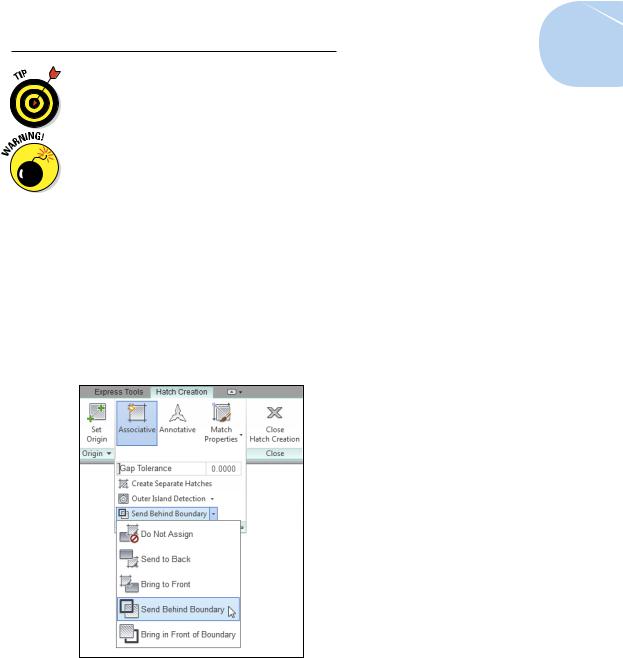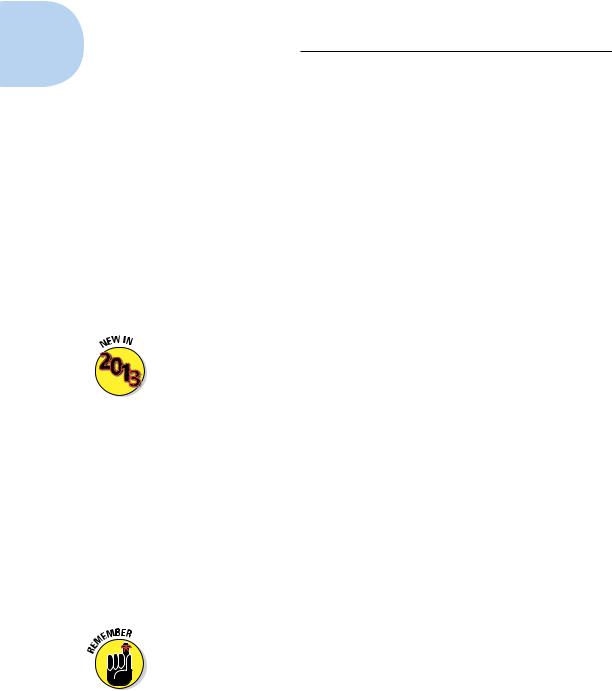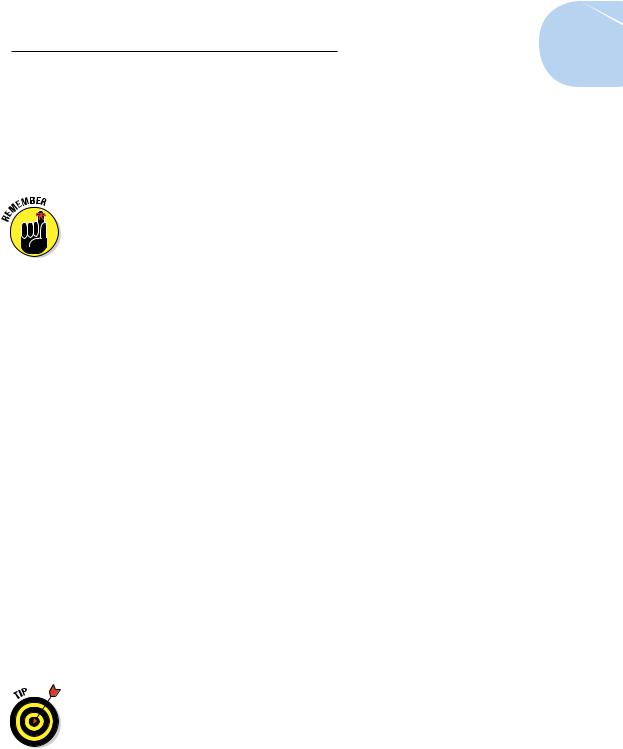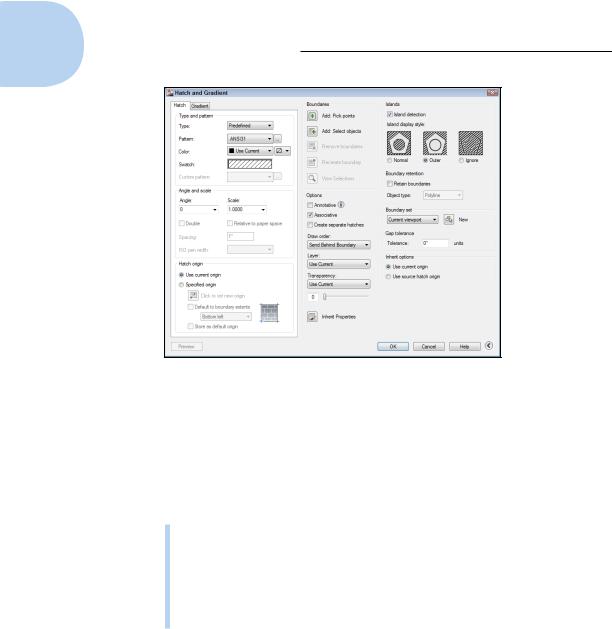
- •About the Authors
- •Dedication
- •Authors’ Acknowledgments
- •Table of Contents
- •Introduction
- •What’s Not (And What Is) in This Book
- •Mac attack!
- •Who Do We Think You Are?
- •How This Book Is Organized
- •Part I: AutoCAD 101
- •Part II: Let There Be Lines
- •Part III: If Drawings Could Talk
- •Part IV: Advancing with AutoCAD
- •Part V: On a 3D Spree
- •Part VI: The Part of Tens
- •But wait . . . there’s more!
- •Icons Used in This Book
- •A Few Conventions — Just in Case
- •Commanding from the keyboard
- •Tying things up with the Ribbon
- •Where to Go from Here
- •Why AutoCAD?
- •The Importance of Being DWG
- •Seeing the LT
- •Checking System Requirements
- •Suddenly, It’s 2013!
- •AutoCAD Does Windows (And Office)
- •And They’re Off: AutoCAD’s Opening Screens
- •Running with Ribbons
- •Getting with the Program
- •Looking for Mr. Status Bar
- •Let your fingers do the talking: The command window
- •The key(board) to AutoCAD success
- •Keeping tabs on palettes
- •Down the main stretch: The drawing area
- •Fun with F1
- •A Simple Setup
- •Drawing a (Base) Plate
- •Drawing rectangles on the right layers
- •Circling your plate
- •Nuts to you
- •Getting a Closer Look with Zoom and Pan
- •Modifying to Make It Merrier
- •Hip-hip-array!
- •Stretching out
- •Crossing your hatches
- •Following the Plot
- •A Setup Roadmap
- •Choosing your units
- •Weighing up your scales
- •Thinking annotatively
- •Thinking about paper
- •Defending your border
- •A Template for Success
- •Making the Most of Model Space
- •Setting your units
- •Making the drawing area snap-py (and grid-dy)
- •Setting linetype and dimension scales
- •Entering drawing properties
- •Making Templates Your Own
- •Setting Up a Layout in Paper Space
- •Will that be tabs or buttons?
- •View layouts Quick(View)ly
- •Creating a layout
- •Copying and changing layouts
- •Lost in paper space
- •Spaced out
- •A view(port) for drawing in
- •About Paper Space Layouts and Plotting
- •Managing Your Properties
- •Layer one on me!
- •Accumulating properties
- •Creating new layers
- •Manipulating layers
- •Using Named Objects
- •Using AutoCAD DesignCenter
- •Copying layers between drawings
- •Controlling Your Precision
- •Keyboard capers: Coordinate input
- •Understanding AutoCAD’s coordinate systems
- •Grab an object and make it snappy
- •Other Practical Precision Procedures
- •Introducing the AutoCAD Drawing Commands
- •The Straight and Narrow: Lines, Polylines, and Polygons
- •Toeing the line
- •Connecting the lines with polyline
- •Squaring off with rectangles
- •Choosing your sides with polygon
- •(Throwing) Curves
- •Going full circle
- •Arc-y-ology
- •Solar ellipses
- •Splines: The sketchy, sinuous curves
- •Donuts: The circles with a difference
- •Revision clouds on the horizon
- •Scoring Points
- •Commanding and Selecting
- •Command-first editing
- •Selection-first editing
- •Direct object manipulation
- •Choosing an editing style
- •Grab It
- •One-by-one selection
- •Selection boxes left and right
- •Perfecting Selecting
- •AutoCAD Groupies
- •Object Selection: Now You See It . . .
- •Get a Grip
- •About grips
- •A gripping example
- •Move it!
- •Copy, or a kinder, gentler Move
- •A warm-up stretch
- •Your AutoCAD Toolkit
- •The Big Three: Move, Copy, and Stretch
- •Base points and displacements
- •Move
- •Copy
- •Copy between drawings
- •Stretch
- •More Manipulations
- •Mirror
- •Rotate
- •Scale
- •Array
- •Offset
- •Slicing, Dicing, and Splicing
- •Trim and Extend
- •Break
- •Fillet and Chamfer and Blend
- •Join
- •When Editing Goes Bad
- •Zoom and Pan with Glass and Hand
- •The wheel deal
- •Navigating your drawing
- •Controlling your cube
- •Time to zoom
- •A View by Any Other Name . . .
- •Looking Around in Layout Land
- •Degenerating and Regenerating
- •Getting Ready to Write
- •Simply stylish text
- •Taking your text to new heights
- •One line or two?
- •Your text will be justified
- •Using the Same Old Line
- •Turning On Your Annotative Objects
- •Saying More in Multiline Text
- •Making it with Mtext
- •It slices; it dices . . .
- •Doing a number on your Mtext lists
- •Line up in columns — now!
- •Modifying Mtext
- •Gather Round the Tables
- •Tables have style, too
- •Creating and editing tables
- •Take Me to Your Leader
- •Electing a leader
- •Multi options for multileaders
- •How Do You Measure Up?
- •A Field Guide to Dimensions
- •The lazy drafter jumps over to the quick dimension commands
- •Dimension associativity
- •Where, oh where, do my dimensions go?
- •The Latest Styles in Dimensioning
- •Creating and managing dimension styles
- •Let’s get stylish!
- •Adjusting style settings
- •Size Matters
- •Details at other scales
- •Editing Dimensions
- •Editing dimension geometry
- •Editing dimension text
- •Controlling and editing dimension associativity
- •Batten Down the Hatches!
- •Don’t Count Your Hatches. . .
- •Size Matters!
- •We can do this the hard way. . .
- •. . . or we can do this the easy way
- •Annotative versus non-annotative
- •Pushing the Boundary (Of) Hatch
- •Your hatching has no style!
- •Hatch from scratch
- •Editing Hatch Objects
- •You Say Printing, We Say Plotting
- •The Plot Quickens
- •Plotting success in 16 steps
- •Get with the system
- •Configure it out
- •Preview one, two
- •Instead of fit, scale it
- •Plotting the Layout of the Land
- •Plotting Lineweights and Colors
- •Plotting with style
- •Plotting through thick and thin
- •Plotting in color
- •It’s a (Page) Setup!
- •Continuing the Plot Dialog
- •The Plot Sickens
- •Rocking with Blocks
- •Creating Block Definitions
- •Inserting Blocks
- •Attributes: Fill-in-the-Blank Blocks
- •Creating attribute definitions
- •Defining blocks that contain attribute definitions
- •Inserting blocks that contain attribute definitions
- •Edit attribute values
- •Extracting data
- •Exploding Blocks
- •Purging Unused Block Definitions
- •Arraying Associatively
- •Comparing the old and new ARRAY commands
- •Hip, hip, array!
- •Associatively editing
- •Going External
- •Becoming attached to your xrefs
- •Layer-palooza
- •Creating and editing an external reference file
- •Forging an xref path
- •Managing xrefs
- •Blocks, Xrefs, and Drawing Organization
- •Mastering the Raster
- •Attaching a raster image
- •Maintaining your image
- •Theme and Variations: Dynamic Blocks
- •Lights! Parameters!! Actions!!!
- •Manipulating dynamic blocks
- •Maintaining Design Intent
- •Defining terms
- •Forget about drawing with precision!
- •Constrain yourself
- •Understanding Geometric Constraints
- •Applying a little more constraint
- •AutoConstrain yourself!
- •Understanding Dimensional Constraints
- •Practice a little constraint
- •Making your drawing even smarter
- •Using the Parameters Manager
- •Dimensions or constraints — have it both ways!
- •The Internet and AutoCAD: An Overview
- •You send me
- •Send it with eTransmit
- •Rapid eTransmit
- •Bad reception?
- •Help from the Reference Manager
- •Design Web Format — Not Just for the Web
- •All about DWF and DWFx
- •Autodesk Design Review 2013
- •The Drawing Protection Racket
- •Autodesk Weather Forecast: Increasing Cloud
- •Working Solidly in the Cloud
- •Free AutoCAD!
- •Going once, going twice, going 123D
- •Your head planted firmly in the cloud
- •The pros
- •The cons
- •Cloudy with a shower of DWGs
- •AutoCAD 2013 cloud connectivity
- •Tomorrow’s Forecast
- •Understanding 3D Digital Models
- •Tools of the Trade
- •Warp speed ahead
- •Entering the third dimension
- •Untying the Ribbon and opening some palettes
- •Modeling from Above
- •Using 3D coordinate input
- •Using point filters
- •Object snaps and object snap tracking
- •Changing Planes
- •Displaying the UCS icon
- •Adjusting the UCS
- •Navigating the 3D Waters
- •Orbit à go-go
- •Taking a spin around the cube
- •Grabbing the SteeringWheels
- •Visualizing 3D Objects
- •Getting Your 3D Bearings
- •Creating a better 3D template
- •Seeing the world from new viewpoints
- •From Drawing to Modeling in 3D
- •Drawing basic 3D objects
- •Gaining a solid foundation
- •Drawing solid primitives
- •Adding the Third Dimension to 2D Objects
- •Creating 3D objects from 2D drawings
- •Modifying 3D Objects
- •Selecting subobjects
- •Working with gizmos
- •More 3D variants of 2D commands
- •Editing solids
- •Get the 2D Out of Here!
- •A different point of view
- •But wait! There’s more!
- •But wait! There’s less!
- •Do You See What I See?
- •Visualizing the Digital World
- •Adding Lighting
- •Default lighting
- •User-defined lights
- •Sunlight
- •Creating and Applying Materials
- •Defining a Background
- •Rendering a 3D Model
- •Autodesk Feedback Community
- •Autodesk Discussion Groups
- •Autodesk’s Own Bloggers
- •Autodesk University
- •The Autodesk Channel on YouTube
- •The World Wide (CAD) Web
- •Your Local ATC
- •Your Local User Group
- •AUGI
- •Books
- •Price
- •3D Abilities
- •Customization Options
- •Network Licensing
- •Express Tools
- •Parametrics
- •Standards Checking
- •Data Extraction
- •MLINE versus DLINE
- •Profiles
- •Reference Manager
- •And The Good News Is . . .
- •APERTURE
- •DIMASSOC
- •MENUBAR
- •MIRRTEXT
- •OSNAPZ
- •PICKBOX
- •REMEMBERFOLDERS
- •ROLLOVERTIPS
- •TOOLTIPS
- •VISRETAIN
- •And the Bonus Round
- •Index

Chapter 15: Down the Hatch! 331
Hatching should be placed on a dedicated layer or layers so it can be easily turned on or off.
Layers for hatching should always use the Continuous line type. Many hatch patterns use noncontinuous lines, and if you put them on a layer with a noncontinuous line type, it confuses things to no end.
By default, when you select a number of closed areas and then press Enter, the hatched areas will be created as a single object; choose Create Separate Hatches on the Options slideout panel if you want to be able to modify each hatched area.
Set the Draw Order drop-down list to specify whether the hatch objects are in front of or behind the hatch boundary or other drawing objects (see Figure 15-5). By default, they get sent behind their boundary, which is typi-
cally what you want. If a hatch is a different color from its boundary and if it’s in front of its boundary, the tips of the hatch objects produce a dotted-line effect along the boundary.
Figure 15-5: Hatch options for every occasion.
Pushing the Boundary (Of) Hatch
In the remainder of this chapter, we show you how to refine the techniques presented in the preceding section. We describe how to copy existing hatching, take advantage of the various options in the Hatch and Gradient dialog
www.it-ebooks.info

332 Part III: If Drawings Could Talk
box (which offers a bit more control than the Hatch Creation contextual tab), and choose more complicated hatching boundaries.
Your hatching has no style!
A minor problem is that unlike text and dimensioning, you can’t create named styles for hatching. The good news is that three workarounds can help offset this.
Plagiarism 101: Editing hatches. Okay, it’s not really plagiarism, but it’s close. Suppose you have a drawing with several different styles of hatching applied. You now realize that one of them has the wrong specifications. No problem. Simply select the problem hatch, which brings up the Hatch Editor tab of the Ribbon. It’s virtually identical to the Hatch Creation tab. From the Hatch Editor tab, you can change any of the properties. The better news is that it also has an Inherit Properties button. Click it, and then click an existing hatch — the original hatch inherits all the properties of the selected hatch.
You can select more than one existing hatch at a time. Any changes you make on the Hatch Editor tab are applied to all the selected hatches.
Plagiarism 201: Cloning hatches. Suppose you have a drawing with several different styles of hatching applied, and now you want to hatch another area. You start the HATCH command, and the Hatch contextual Ribbon appears. Oops, it shows the specifications of the last hatch that was applied, which is quite different from what you want to do now. No problem; simply click the Match Properties button on the Options panel of the Hatch Creation tab, or the Inherit Properties button in the Hatch and Gradient dialog box. Pick an existing hatch, and hey! Presto! All the settings update to match the selected hatch! You can use the cloned settings as is, or you can modify them as desired.
Plagiarism 301: Palettizing hatches. Here’s one that even many experienced users miss. It is remarkably easy to customize AutoCAD so that a single mouse-click can produce any hatch style you want. Here’s how:
1.Apply a Hatch with the desired properties.
If your existing drawing has such a hatch, this step can be skipped.
Make sure that the existing hatch is on the correct layer and that the layer has all the correct properties.
2.Display the Tool Palette window.
Select the Tool Palettes tool from the Palettes panel of the View tab of the Ribbon. We discuss tool palettes in Chapter 2.
www.it-ebooks.info

Chapter 15: Down the Hatch! 333
3.Display the Hatches and Fills palette by clicking its tab.
If you can’t see this tab, click the overlapping edges of the tabs at the bottom of the palette window and select Hatches and Fills from the list that appears.
4.Create your new Hatch tool.
Click once to select the existing hatch object, pause, and then select it again. Drag it onto the tool palette and drop it.
Don’t double-click too quickly, and don’t click the blue grip, or you’ll just end up editing the existing object.
5.Use your new Hatch tool.
Click your hatch tool and then click inside a closed boundary in your drawing. Bingo! Instant hatching to your desired specifications! Note that it even puts hatching on the same layer as the original sample.
But wait! There’s more! If you start a new drawing, create a boundary, and then use your Tool palette to hatch it, you’ll be amazed to find that the new hatching in the new drawing is on the correct layer. If the correct layer doesn’t exist in the new drawing, AutoCAD creates it to match the original specifications.
This is standardization through customization.
Hatch from scratch
An alternative to using the Ribbon is the Hatch and Gradient dialog box, as shown in Figure 15-6. You don’t see your hatch object updating as you
change settings the way you do with the Ribbon, but you do have a bit more control over what you’re going to end up with. To display the Hatch and Gradient dialog box, click the dialog box launcher (the teeny arrow at the right end of the Options panel of the Ribbon’s Hatch Creation tab).
You can use predefined, user-defined, or custom hatch patterns. Most of the time, you’ll choose predefined hatch patterns unless some generous soul gives you a custom pattern. On the other hand, we haven’t used a userdefined pattern in over 25 years of using AutoCAD. They consist solely of continuous lines. All you can define is the spacing, the rotation angle, and whether the lines are parallel pairs. And all this can be duplicated with standard patterns.
By default, the right third of the Hatch and Gradient dialog box is hidden; to see the additional hatch options at the right side of the dialog box, shown in Figure 15-6, click the More Options arrow beside the Help button.
www.it-ebooks.info

334 Part III: If Drawings Could Talk
Figure 15-6: The Hatch tab of the expanded Hatch and Gradient dialog box.
Pick a pattern, any pattern: Predefined hatch patterns
To use AutoCAD’s predefined hatch patterns, select Predefined from the Type drop-down list at the top of the Hatch tab in the Hatch and Gradient dialog box. This selection sets the stage for choosing the hatch pattern.
You specify a predefined hatch pattern in one of two ways:
Pattern drop-down list: If you know the name of the hatch pattern, select it from the Pattern drop-down list. The list is alphabetical, except that SOLID (that is, a solid fill) appears at the very beginning.
Pattern button: If you don’t know the pattern name or if you prefer the visual approach, click the Pattern button (the tiny button with the ellipsis [three dots] to the right of the Pattern drop-down list and pattern name) to display the Hatch Pattern Palette with pattern previews and names.
Figure 15-7 shows some of the other predefined hatch patterns, which cover everything from Earth to Escher to Stars.
When is a pattern not a pattern? When it’s a solid fill
AutoCAD treats filling an area with a solid color as a type of hatching. Simply choose SOLID from the top of the Pattern drop-down list. You’ll also see several gradient-fill options.
www.it-ebooks.info
